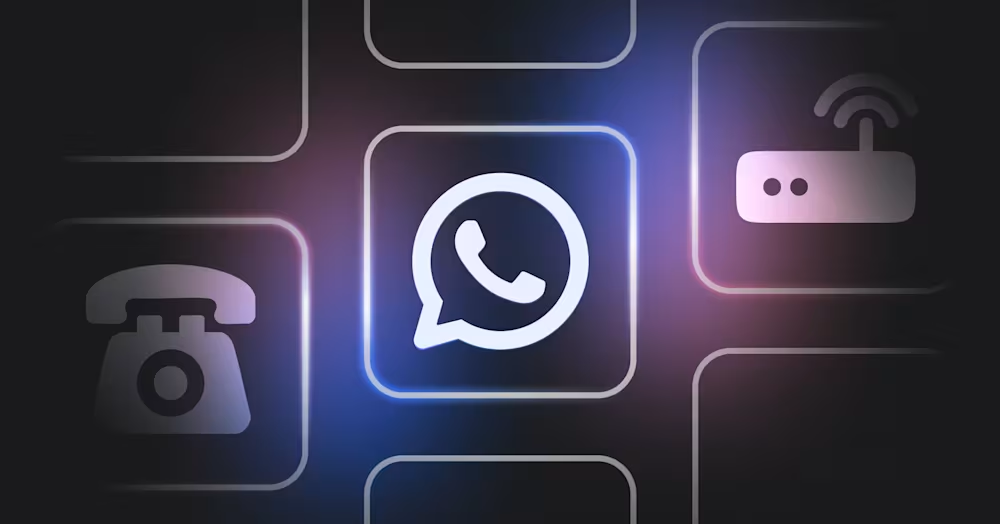
VoIP vs Landline vs WhatsApp Business Calling API
In this article, we'll compare VoIP vs Landline vs WhatsApp Business Calling API to help you decide which one is the best choice for your business.
![Messaggistica d'affari: una guida ai messaggi per le imprese [luglio 2024]](https://assets2-proxy.respond.io/ph8r57dk1q9w/1v2H7hpthC97j7I4gpuXFi/25fe3c5feed7b82a804bb7078c9b02a8/concepts-what-is-business-messaging-cover_efc8b290908932f8b62fe4bf6abbc56e.png?q=70&fm=avif)
Le aziende stanno saltando sulla tendenza di messaggistica di business contattando i clienti su applicazioni come WhatsApp, Facebook Messenger, LINE, Viber e altro ancora. Oggi è una parte critica di molte imprese in tutto il mondo. Ma come funziona? In questo articolo, imparerai cosa è la messaggistica aziendale, come avvantaggia la tua azienda e come il giusto software di messaggistica aziendale può migliorare questa pratica.
Più di 3 miliardi di persone in tutto il mondo utilizzano applicazioni di messaggistica per comunicare tra loro. Ora è il modo dominante di comunicare online, dall'avere conversazioni occasionali alla pianificazione di eventi familiari.
Gli ultimi anni hanno visto le aziende utilizzare applicazioni di messaggistica per raggiungere meglio i loro clienti. Le imprese hanno persino effettuato notevoli investimenti per realizzare questo obiettivo.
Oggi, la maggior parte delle nostre conversazioni online si verificano attraverso applicazioni di messaggistica istantanea. Le chiamate, i testi e le e-mail sono caduti fuori favore. Ci sono diverse ragioni per questo. In primo luogo, le app di messaggistica istantanea sono gratuite, il che è un fattore importante nel loro alto tasso di adozione.
Inoltre, hanno molte caratteristiche che migliorano l'esperienza di comunicazione. Leggi le ricevute ti fa sapere quando il destinatario ha letto il tuo messaggio. Le emoji, le gif e gli adesivi ti offrono più opzioni per esprimerti.
Tutte queste grandi caratteristiche hanno prodotto effetti collaterali. I clienti si aspettano risposte rapide, soprattutto quando i messaggi sono stati letti. I tuoi clienti potrebbero vederlo come un servizio scadente se non rispondi rapidamente ai loro messaggi.
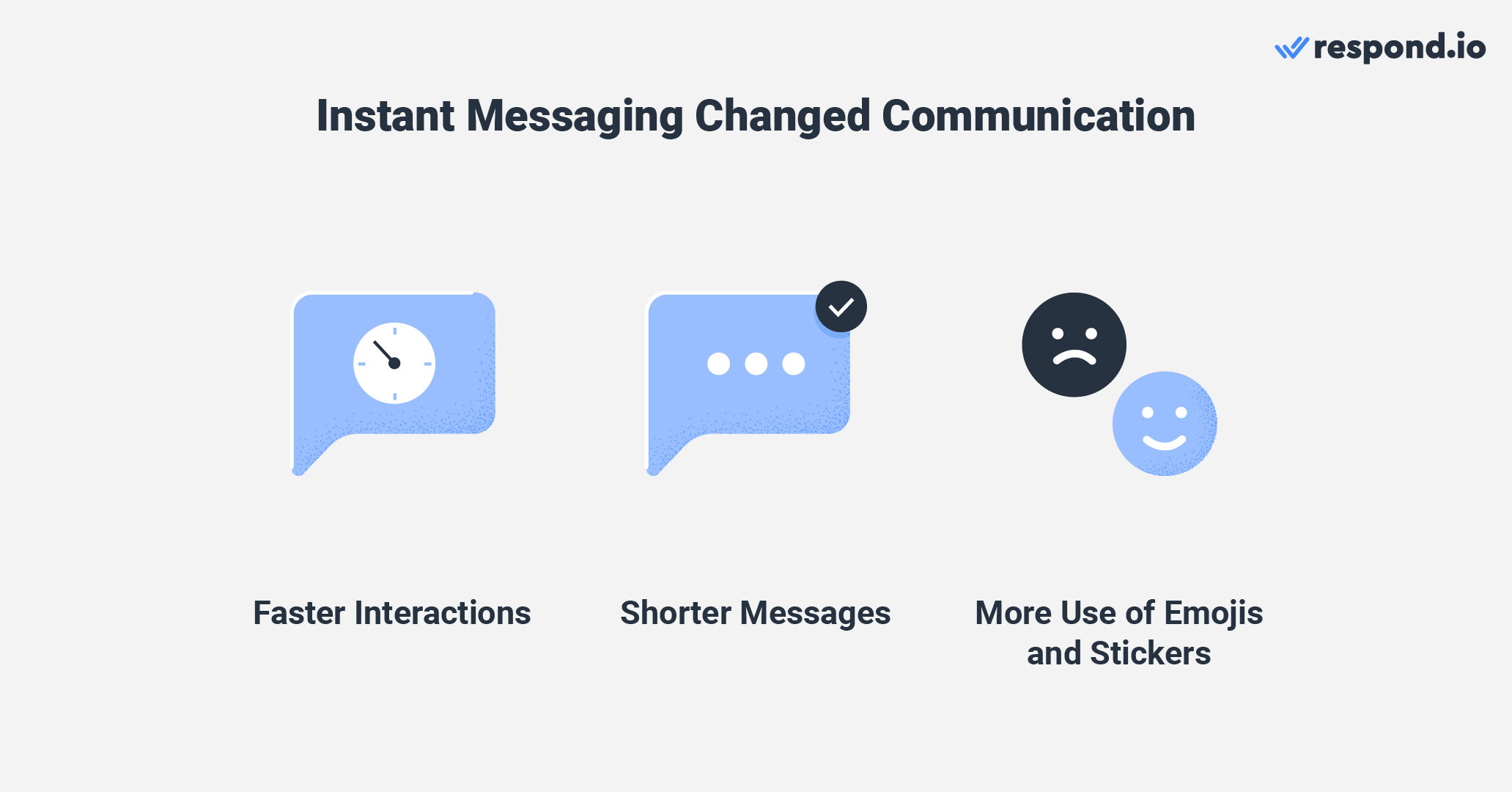
Anche i lunghi blocchi di testo non sono ben accolti. Se non utilizzi emoji e adesivi, può dare l’impressione che tu sia troppo serio. In alcuni casi, i messaggi possono sembrare freddi o poco amichevoli, anche se questa non è la tua intenzione.
Tutto questo è in netto contrasto con la comunicazione via e-mail, che è formale e lento. Nonostante ciò, molte aziende utilizzano ancora la posta elettronica come loro principale mezzo di comunicazione.
Anche se la nostra comunicazione personale è cambiata, le imprese dovrebbero fare lo stesso? Nella sezione successiva, diamo un'occhiata a come le aziende possono utilizzare la messaggistica istantanea a loro vantaggio.
La messaggistica aziendale ha “democratizzato” il commercio dando alle imprese di tutte le dimensioni i mezzi per commercializzare i loro prodotti direttamente ed efficacemente ai clienti. Canali tradizionali come e-mail e telefonate non possono offrire la stessa versatilità e risultati.
In questa sezione, ci concentreremo su come si vince quando si adotta la messaggistica aziendale per quanto riguarda le relazioni con i clienti e la generazione di entrate.
La messaggistica aziendale colma il divario nella customer experience in un modo che i canali tradizionali non possono. A differenza dei canali tradizionali, non c'è alcuna pressione per avere le chiamate più brevi possibili o per trascinare una tonnellata di informazioni in un unico SMS.
conversazioni sulle app di messaggistica istantanea si sentono più casuali che formali. Questo aiuta a prevenire un senso di distanza dai vostri clienti e stabilire legami più stretti con loro. È la cosa più vicina incontrare e parlare con loro di persona senza essere in realtà lì.
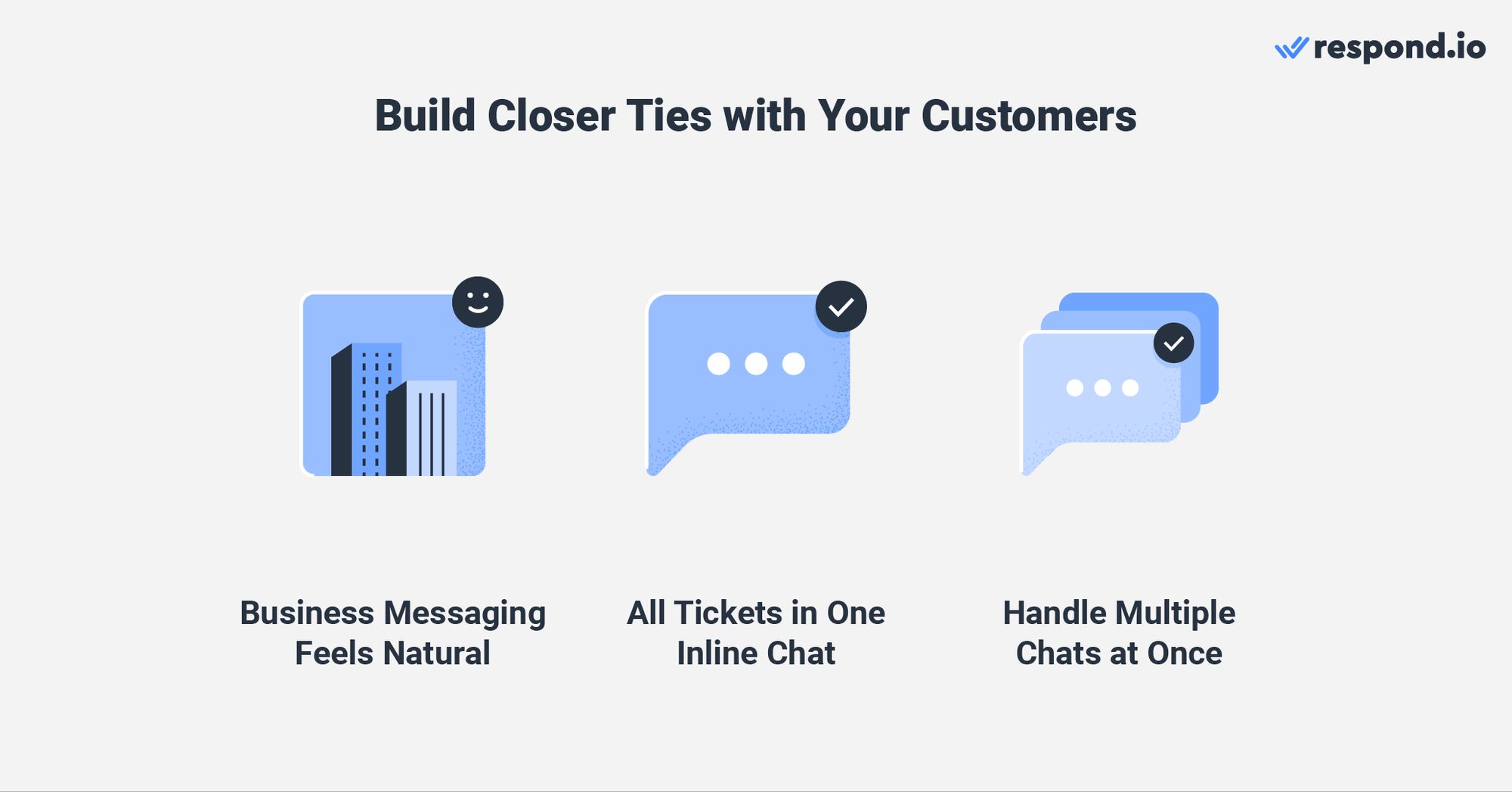
Questo rapporto è ulteriormente costruito con l'uso della cronologia della chat. Fornisce all'agente il contesto necessario prima di rispondere a qualsiasi indagine. Questo evita ai clienti di doversi ripetere e aiuta a risolvere le query il prima possibile.
Inoltre, gli agenti possono partecipare a più conversazioni per volta tramite messaggistica istantanea. Ciò significa che i vostri clienti non devono mai aspettare molto prima di ricevere una risposta, dando loro un senso di essere prioritari.
Conversational commerce è un modo per creare un'esperienza incentrata sul cliente quando si tratta di fare acquisti unendo l'e-commerce con le app di messaggistica aziendale. È un gateway per i clienti per raggiungerti direttamente.
In quanto tale, ha vantaggi rispetto ai mezzi tradizionali di condurre vendite. I messaggi relativi alle vendite hanno un 5X open rate più alto rispetto alle email. Ciò consente agli agenti di vendita di impegnarsi in prospettive e incoraggiare le risposte successive rapidamente.

La natura personalizzata della messaggistica aziendale e un migliore coinvolgimento dei clienti possono aumentare le conversioni di vendita. Gli agenti di vendita possono fornire rapidamente assistenza al cliente con le informazioni necessarie per chiudere le vendite.
Nonostante i molti vantaggi che la messaggistica di business ha da offrire, ci sono sfide che devono affrontare quando lo utilizzano.
Trasforma le conversazioni dei clienti in crescita aziendale con respond.io. ✨
Gestisci chiamate, chat ed email in un unico posto!
Prima di adottare la messaggistica istantanea per le comunicazioni dei clienti, è necessario superare alcune sfide.
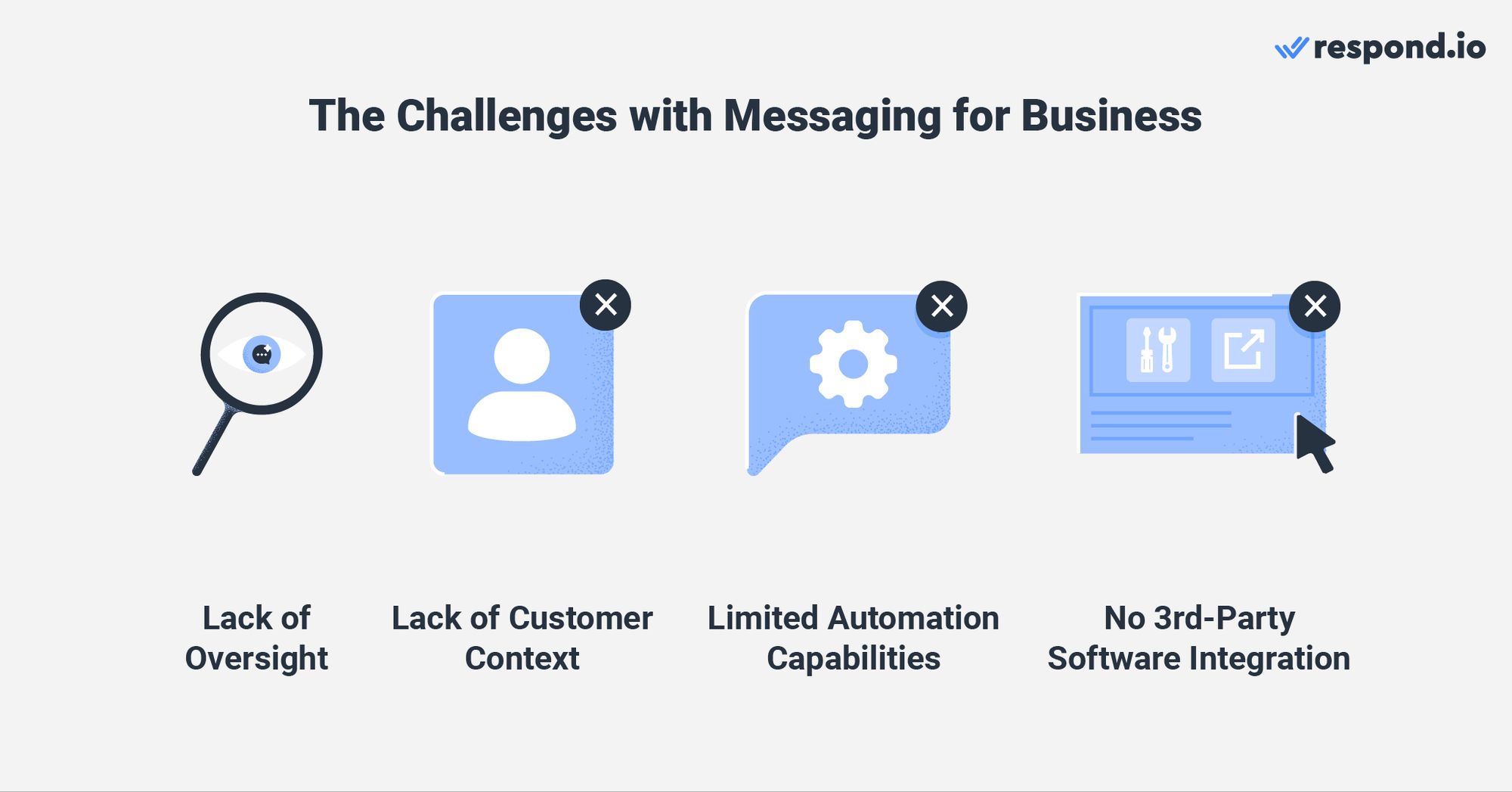
Qui ci sono alcuni degli ostacoli che le aziende affrontano quando cercano di incorporare messaggi di business come parte delle loro operazioni.
Utilizzando le app di messaggistica personale, i manager non possono supervisionare ciò che gli agenti stanno dicendo ai clienti. Senza un sistema centralizzato o una posta in arrivo condivisa, garantire una messaggistica coerente e un servizio clienti di qualità diventa difficile.
Questa visibilità limitata rende difficile individuare aree di miglioramento o fornire feedback tempestivo agli agenti, poiché dire la cosa sbagliata può potenzialmente danneggiare le relazioni con i clienti e avere un impatto negativo sulla reputazione dell'azienda.
Inoltre, le applicazioni di messaggistica personale come WhatsApp Business App non offrono alcun meccanismo integrato per misurare le prestazioni degli agenti. Senza indicatori chiave di performance o metriche da tracciare, i manager faticano a valutare la produttività agente, tempi di risposta o livelli di soddisfazione dei clienti.
Ci sono momenti in cui un cliente può contattarti attraverso più di un'app di messaggistica. Ciò comporta la dispersione delle conversazioni dei clienti su diverse piattaforme.
Senza il giusto contesto, gli agenti possono avere difficoltà a fornire risposte accurate e tempestive. Potrebbero non essere a conoscenza delle conversazioni precedenti o avere accesso al profilo completo del cliente, risultando in un'esperienza di servizio clienti disarticolata e inefficiente.
Gli agenti potrebbero duplicare gli sforzi, fornire informazioni ridondanti o porre domande ripetitive a causa della mancanza di visibilità nelle interazioni precedenti con il cliente.
Ciò può portare a frustrazione e insoddisfazione da parte del cliente, poiché ci si aspetta un'esperienza omnicanale fluida e coerente quando si interagisce con un'azienda attraverso diversi canali di messaggistica.
La mancanza di funzionalità di automazione nelle applicazioni di messaggistica pone ulteriori sfide per le imprese. Alcune app come WhatsApp Business App offrono funzionalità di automazione di base come la risposta automatica.
Tuttavia, le loro capacità sono spesso limitate e insufficienti per compiti complessi, soprattutto per le grandi imprese. Questa limitazione si manifesta in due aree critiche: la gestione delle conversazioni in entrata e l'efficienza generale nell'affrontare le richieste dei clienti.
Per esempio, contattare routing e assegnazione svolgono un ruolo cruciale nella riduzione dei tempi di risposta, garantire che i contatti siano inviati agli agenti giusti e fornire un'esperienza clienti senza interruzioni. Le imprese che si basano su processi manuali aumentano il rischio di conversazioni errate o di risposte ritardate.
Per le aziende che si affidano a software di terze parti come Hubspot, Zapier e Salesforce, l'incapacità di integrare le applicazioni di messaggistica con queste piattaforme perturba l'efficienza del flusso di lavoro e la gestione dei dati.
Le informazioni raccolte attraverso interazioni di messaggistica non fluiranno senza soluzione di continuità nel software consolidato, creando silos di dati e ostacolando le informazioni complete dei clienti.
Ciò può portare alla frammentazione dei dati, causando ulteriori inefficienze poiché gli agenti devono navigare tra più piattaforme per accedere alle informazioni dei clienti e fornire supporto personalizzato.
Come possono le imprese affrontare tutte queste sfide quando adottano messaggi istantanei? C'è un modo per servire meglio il pubblico, mantenere i vantaggi della messaggistica istantanea e superare queste sfide.
Respond.io è stato sviluppato per affrontare gli ostacoli che le imprese devono affrontare quando si adotta la messaggistica istantanea. Si tratta di un software di gestione delle conversazioni del cliente che è pieno di caratteristiche che rendono la messaggistica aziendale più facile e più potente.
Connettiti a canali di messaggistica popolari come WhatsApp e Telegram e ospitali tutti in una casella di posta omnicanale.
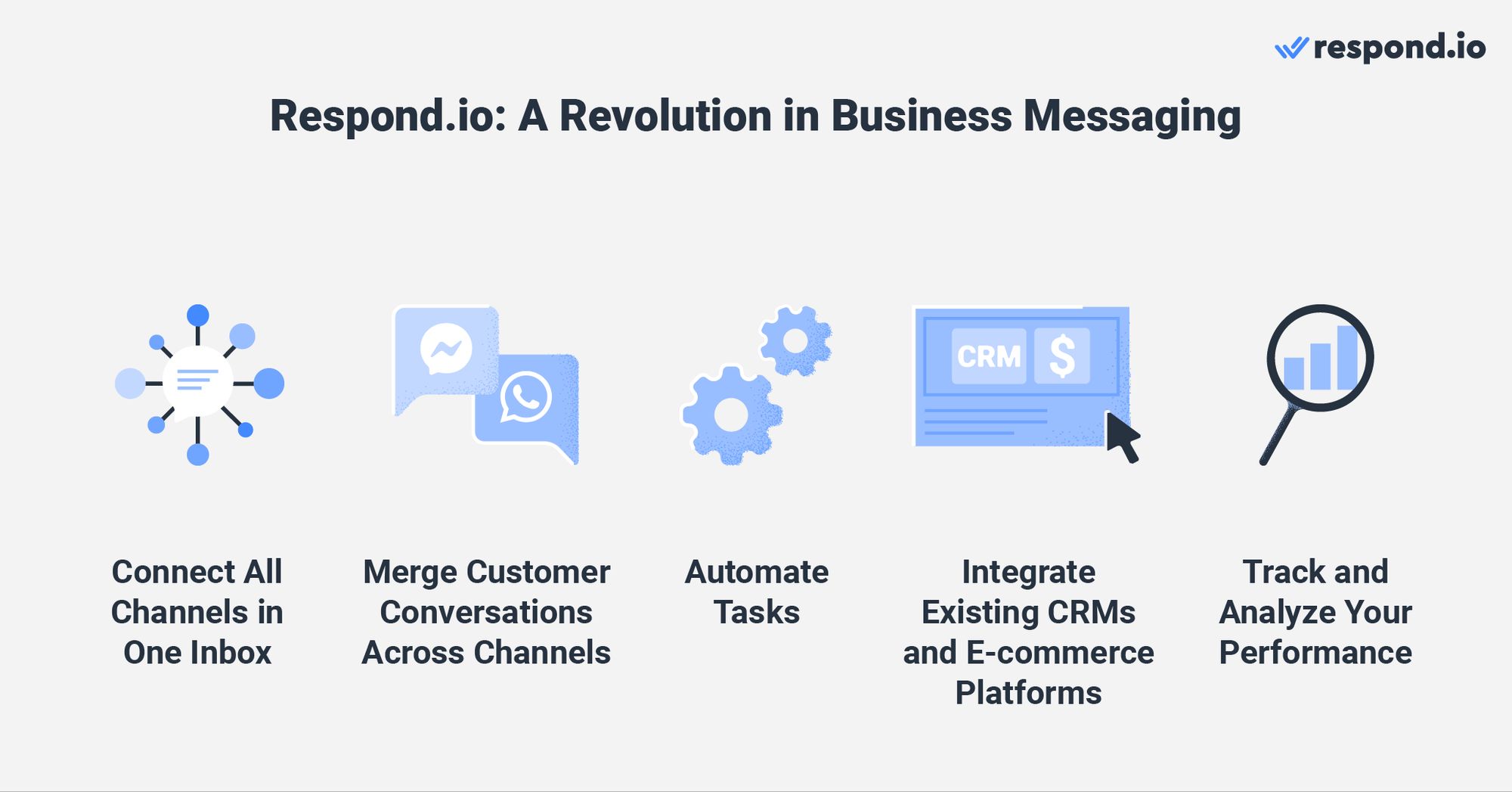
Tieni traccia delle conversazioni dei clienti attraverso canali diversi in un thread di unendo i contatti, imposta trasmissioni per canali multipli da un singolo generatore di broadcast e automatizza attività complesse come chat di routing e assegnando i contatti agli agenti.
È inoltre possibile integrare le piattaforme esistenti CRM e e-commerce e analizzare le prestazioni degli agenti e trasmissioni.
Business messaging crescerà solo e le aziende che non sono su questi canali rischiano di perdere una base di clienti significativa. Non vuoi lasciarti indietro? Iscriviti a una prova gratuita con respond.io e inizia a utilizzare la messaggistica aziendale per chattare con i tuoi clienti oggi.
Trasforma le conversazioni dei clienti in crescita aziendale con respond.io. ✨
Gestisci chiamate, chat ed email in un unico posto!
Vuoi saperne di più sulla messaggistica aziendale per servire meglio il tuo pubblico? Leggi gli articoli qui sotto per saperne di più:
Benjamin Steve Richard si è unito respond.io come scrittore di contenuti nel 2023. In possesso di una laurea in Giurisprudenza presso l'Università di Londra, Benjamin fornisce risorse preziose sulle app di messaggistica per le aziende per aiutarle a sfruttare con successo le conversazioni con i clienti.

In this article, we'll compare VoIP vs Landline vs WhatsApp Business Calling API to help you decide which one is the best choice for your business.